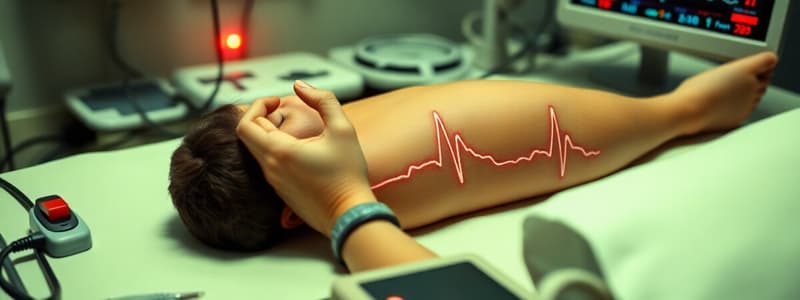Podcast
Questions and Answers
A patient with unstable wide complex tachycardia is not responding to initial defibrillation attempts. What is the MOST appropriate next intervention?
A patient with unstable wide complex tachycardia is not responding to initial defibrillation attempts. What is the MOST appropriate next intervention?
- Perform needle decompression to rule out tension pneumothorax.
- Begin a Dopamine infusion at 5 mcg/kg/min to increase blood pressure.
- Administer Adenosine 6 mg IV push followed by a saline flush.
- Administer Magnesium Sulfate 2 gm IV/IO in 50 ml NS over 10 minutes. (correct)
A patient with unstable polymorphic ventricular tachycardia (Torsades de Pointes) is being treated. After initial defibrillation and magnesium administration, the rhythm persists. Which medication should be considered next?
A patient with unstable polymorphic ventricular tachycardia (Torsades de Pointes) is being treated. After initial defibrillation and magnesium administration, the rhythm persists. Which medication should be considered next?
- Sodium Bicarbonate 50 mEq IV push.
- Epinephrine 1 mg IV push every 3-5 minutes.
- Amiodarone 150 mg in 50 ml NS over 10 minutes. (correct)
- Atropine 0.5 mg IV push.
A patient with unstable wide complex tachycardia requires synchronized cardioversion. Prior to the procedure, which medication should be considered?
A patient with unstable wide complex tachycardia requires synchronized cardioversion. Prior to the procedure, which medication should be considered?
- Naloxone 0.4 mg IV push.
- Furosemide 40 mg IV push.
- Dextrose 50% 25 grams IV push.
- Etomidate 0.15 mg/kg IV/IO. (correct)
After administering amiodarone to a patient with persistent unstable ventricular tachycardia, there is no change in the patient's rhythm, what is the next step?
After administering amiodarone to a patient with persistent unstable ventricular tachycardia, there is no change in the patient's rhythm, what is the next step?
When managing a patient with Torsades de Pointes, after defibrillation and magnesium sulfate administration, the patient's rhythm converts and they become hypotensive, what intervention should be considered?
When managing a patient with Torsades de Pointes, after defibrillation and magnesium sulfate administration, the patient's rhythm converts and they become hypotensive, what intervention should be considered?
Flashcards
Unstable Tachycardia
Unstable Tachycardia
Rapid heart rate with mental status changes and no palpable radial pulse, requiring immediate intervention.
Torsades de Pointes
Torsades de Pointes
A life-threatening polymorphic ventricular tachycardia characterized by a twisting of the points around the baseline on ECG.
Defibrillation
Defibrillation
Deliver an unsynchronized high-energy electrical shock to terminate life threatening arrhythmias
Etomidate
Etomidate
Signup and view all the flashcards
Magnesium Sulfate
Magnesium Sulfate
Signup and view all the flashcards
Study Notes
-
Tachycardia/Unstable indicates mental status changes with no palpable radial pulse
-
Focus on the general adult assessment and cardiac monitoring
-
Establish vascular access
-
Wide Complex ECG: ≥0.12 Sec
-
Torsades de Pointes (Polymorphic Ventricular Tachycardia)
-
Defibrillate
-
Consider sedation: Etomidate 0.15 mg/kg IV/IO
-
Check for rhythm change
-
If no rhythm change: Magnesium Sulfate 2 gm IV/IO in 50 ml NS over 10 min
-
Checks for rhythm change
-
If no rhythm change: Repeat Defibrillation, Assess need for repeat sedation
-
Check for rhythm change
-
Monomorphic VT
-
Synchronized Cardioversion, consider sedation and analgesia; for medications and dosages refer to electrical therapy/synchronized cardioversion procedures protocol
-
Check for rhythm change
-
If no rhythm change: Amiodarone 150 mg in 50 ml NS over 10 min
-
Check for rhythm change
-
If no rhythm change: Repeat synchronized cardioversion or defibrillate if VT is not resolved; assess need for repeat sedation
-
Check for rhythm change
Studying That Suits You
Use AI to generate personalized quizzes and flashcards to suit your learning preferences.




